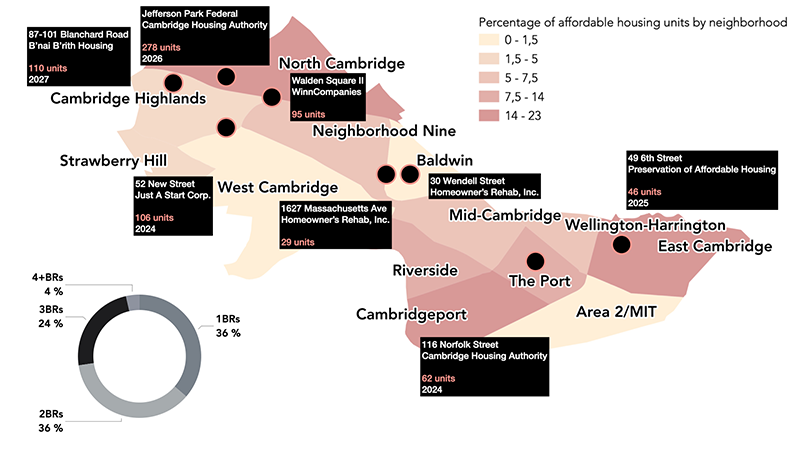What Has Zoning Reform Accomplished in Cambridge, Massachusetts?
Our latest America’s Rental Housing report highlighted the first-of-its-kind 100 Percent Affordable Housing Overlay (AHO) in Cambridge, Massachusetts as an example of how communities are changing zoning to address the affordable housing crisis. Passed in 2020, the AHO sought to remove barriers to affordable housing construction throughout Cambridge. The city has since implemented and adapted this new zoning framework, putting an amended Affordable Housing Overlay 2.0 into practice last October. Although the AHO is on track to meet some of its goals, numerous obstacles and challenges remain.
When it was first enacted, the AHO had three primary goals. First, the zoning reform was intended to rebalance an uneven geography of affordable housing construction, and specifically to encourage development in West Cambridge. The second goal was to build 3,175 units between 2018 and 2030, to help meet some of the needs of the Cambridge Housing Authority’s 21,000 person waiting list. The third goal was to provide more certainty to developers—making them more competitive in bidding—through a permitting process that guaranteed affordable projects would be approved if they met certain criteria.
The Impact of AHO on the Cambridge Housing Stock
To date, there are eight AHO developments with 727 units actively underway, and a dozen more under review. While this may seem like a meager level of construction, it is a significant increase over the 50-60 new units per year the city was previously producing. And as intended, the AHO is enabling a diverse mix of public, private, and non-profit developers to build in the city. The units currently underway are all intended as rentals. They will serve more than 2,000 residents, the majority of whom (98 percent) have incomes under $78,500 per year (earning up to 80 percent of area median income), and most of the units (63 percent) are family-sized (2-4 bedroom). The current projects are in parts of Cambridge that previously had little affordable housing development, meeting one of the AHO’s main goals (Figure 1).
Figure 1: AHO Projects Underway, Some in Neighborhoods That Have Seen Little Recent Affordable Housing Development
Of the eight projects underway, five have completed the AHO Community and Advisory Design Review processes. The city’s Community Development Department is also continuously evaluating sites for development that may be possible through the AHO, through a mix of new development, rehabilitation, and adaptive reuse. These projects would seek to provide housing for people who were formerly unhoused, replace structurally obsolete apartments in public housing, offer bigger units for families, or put historic but unused buildings to productive use.
Additionally, AHO 2.0’s main amendment allows a steeper increase in density and height. For projects that are 100 percent affordable to households making up to 80-100 percent of area median income, the AHO allows building at greater heights and density with reduced setback requirements, up to 12 stories along the city’s main corridors, and to 15 stories in its main business districts. The argument for the height limit amendment is in part justified by the cost of taller buildings: certain building heights require different construction techniques that can increase the cost of a project, but when more units are built on the same amount of land, the project can be more cost-effective.
The AHO is also reducing costs for developers by shortening the permitting process. The Community Development Department estimates that the annual cost of holding a site for construction, while securing permitting and assembling financing, ranges from $65,000 to $80,000; this is less than typical costs, which could exceed $200,000 depending on the site price and financing terms, because the city’s Affordable Housing Trust supports acquisition costs. The AHO therefore reduces carrying costs by shortening the period between site purchase and construction start.
Successes, Ongoing Challenges, and Lessons for Other Communities
Like many cities across the country, Cambridge is facing an affordable housing shortage. Cuts in federal funding have significantly slowed the construction of affordable housing in the last decade. The costs of both land and buildings are soaring, and affordable housing developers often cannot compete with for-profit developers. Prior to 2020, the zoning in Cambridge did not allow multifamily housing in a third of residential neighborhoods, limiting the supply of affordable units. Taken together, these factors have priced many residents out of the city.
The adoption of AHO has been divisive and controversial with both the city council and the public. Worries about overdevelopment or high-rises “Manhattanizing” main streets have emerged, in addition to more colorful references to historical high-rise housing failures. In practice, however, the insufficiency of state and federal housing subsidies for affordable housing projects is expected to limit the impact of AHO 2.0.
Zoning and permitting changes alone will not solve the affordable housing shortage in Cambridge. However, the AHO has the potential to set a new industry standard for other cities using all the tools available to alleviate affordability burdens. And while the housing needs that AHO is trying to address are specific to Cambridge, it's attempting to solve the problems that many communities are facing. Indeed, Boston, Somerville, Berkeley, and Salt Lake City are all considering similar measures. Each will need to understand the unique challenges of their own city and determine how zoning reform can help them address their affordable housing shortage.


